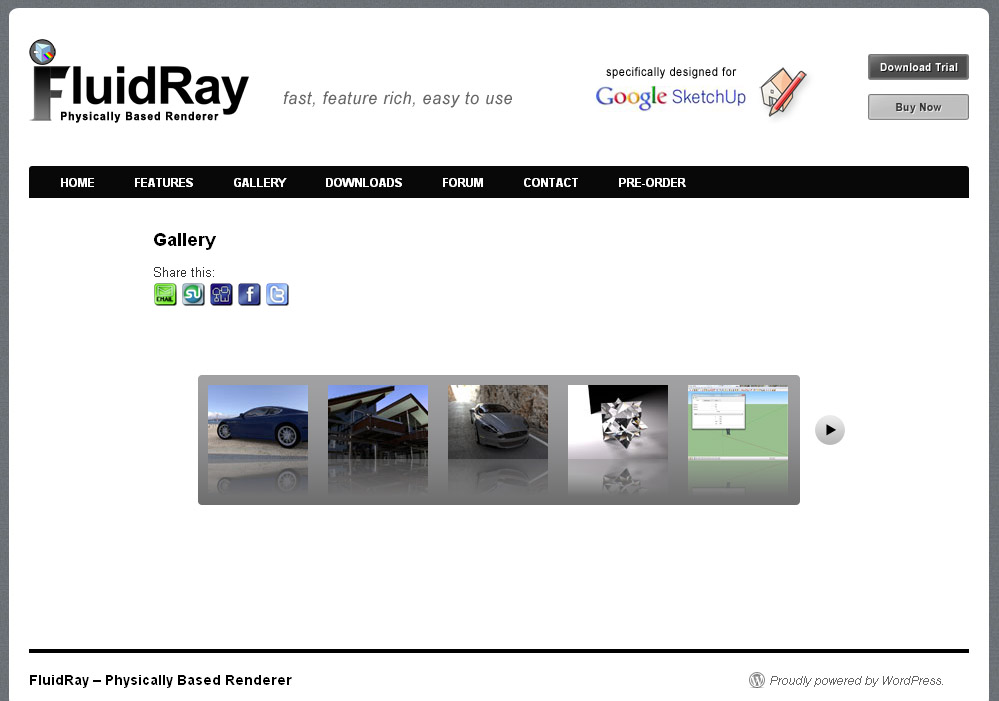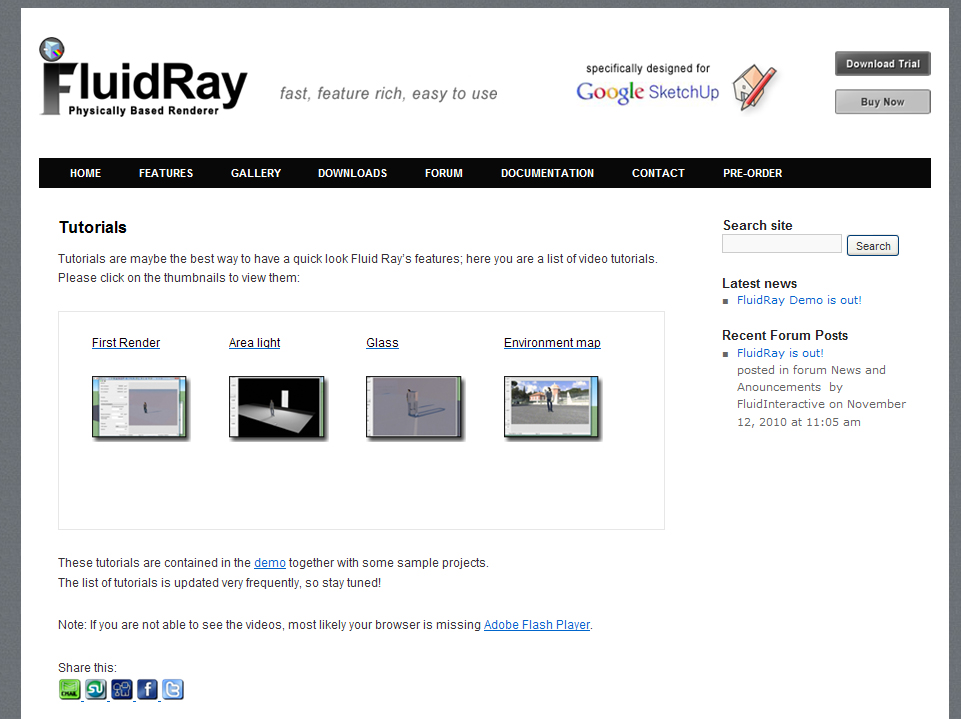Another new integrated renderer
-
Just saw the advert:
Might be interesting to check out for some of you guys...
... I for one am very happy with what I have already

cheers
a. -
They need screenshots of their UI... I'm not so keen on downloading software without seeing how the UI looks first.
-
Not so fast, thomthom, cause they actually have screenshots of their UI...
You can check out the Gallery -> Tutorials...
Wonder what render engine runs behind the hood...
Looking at some of the easy scenes in the tutorials, the time it takes to render a fairly simple scene seem very long and they don't have any information about the computer they've used for these renders...
It could have been an i7 core...Any way... I'll keep my eyes open and see what this application offers...
-
@frederik said:
You can check out the Gallery -> Tutorials...
@unknownuser said:
Forbidden
You don't have permission to access /tutorials/ on this server.
Seems to be some launch hickups....
-
Tested it - really slow. Deleted.
-
Same here...
Link to the gallery hopefully works, there you find some screenshots...
-
all links lead to this:

-
Hm, from my link I get this:

-
@thomthom said:
@frederik said:
You can check out the Gallery -> Tutorials...
@unknownuser said:
Forbidden
You don't have permission to access /tutorials/ on this server.
Seems to be some launch hickups....
Could be some "launch hickups"...
Nonetheless - when I follow/click the link I posted earlier, I do get the following...

-
Seems to have been some under construction issues yes. I sent earlier today en email requesting UI screenshots.
-
Hi Everybody,
I'm Nicola Candussi from FluidRay.com. We are constantly working at improving the clarity of our website so people can better appreciate what FluidRay can offer.
We posted some screenshots of the UI in the Gallery: http://www.fluidray.com/gallery
Also, we have the tutorials online: http://www.fluidray.com/documentation/tutorialsPlease also note that the tutorials are made on extremely simple scenes on purpose, to give a quick overview of the work-flow. They shouldn't be taken as the deciding factor of what the underlying render engine is capable of.
The render engine, developed in-house, is a bidirectional path tracer with Metropolis sampling, which is really among the best algorithms that the current research in unbiased physically based rendering can offer. Where it really shines is in complex scenes with realistic materials and complex lighting configurations.
Nevertheless, we are currently working on optimizations and feature improvements.
All the tutorials and the renderings in the gallery were made with a three years old quad-core 2.4Ghz Q6600.We greatly appreciate all your feedback, since it really is the way for us to improve FluidRay.
Nicola Candussi
-
Too slow - but not expensive.
-
I've only tested this application very briefly and already have some questions...
1.) I can't seem to get soft shadown in my renders...
Have this option been excluded?
Is it possible to get soft shadows - and if YES, how do I get it?2.) Although I feel comfortable with quite sofisticated render applications, I find a lot of the terms used to set-up materials very technical (adjacent to engineering terms)...
Do you plan to make this easier?3.) Seem as if I'm only able to use Sun as light source...
Will it be possible to use point- and spot-light, IES-light and material light/emitter components...??I'm sure I'll have more questons ready soon...

-
Hi Frederik,
Yes, you can get soft shadows in your renders, it all depends on the light setup you are using. I assume you are using the sun and sky, which are there by default (They are called infinite emissions - meaning light coming ideally from infinity). The sun, in particular, produces very sharp shadows, since it's rays are almost parallel to each other.
There are multiple ways to get soft shadows: If your scene is an exterior, you can just remove the sun and leave the sky. Or, you can remove the sun and use a "distant" infinite emission and turn up the cone angle parameter. Or you can use an environment map. Please check the "environment map" tutorial for a quick overview of the process.Besides this, every Sketchup surface can emit light, you just have to set it up in the material editor. This allows you to create an area light for example, which will give you soft shadows. Please check the "area light" tutorial about that.
The way you can set up surface emission is very tweakable, and support for IES light profiles will be there very soon.
FluidRay does not have point lights or spotlights for now, because in real life, it's impossible to create a light source that is infinitely small and infinitely bright (even a light bulb has a surface). Said that, in FluidRay it's still possible to create point light or spot light effects in a physically correct way. For example, you can create a small sphere an make it emit all over its surface, and you'll have a point light.
Support for ideal lights like spot lights and point lights is planned, but since it can produce results that are not physically correct, we gave it a lower priority.Can you please point out the which terms are you referring to? The material parameters? That would greatly help us increase the clarity and usability of FluidRay.
Thanks for your questions, they are of great help!

Nicola Candussi
-
Hi Nicola,
Thanks for the answers...

Have to say that I find your material editor extremely difficult to use...
There's so many terms used - not to mention steps you need to go through - just to create a simple glass material...I.e. How do I create a glass material, which allows the sun-light to pass through the window...??
@fluid said:
For example, you can create a small sphere an make it emit all over its surface, and you'll have a point light.
Now... I know this is doable, but I also know that even with an unbiased render it will increase the render time tremendously...
@fluid said:
Support for ideal lights like spot lights and point lights is planned, but since it can produce results that are not physically correct
Please don't explain to me about physically correct render applications...
If you take a look at my signature, I'm sure you'll find out what I refer to...
In all other unbiased render applications I know, you have point- and spot-light as well as IES and projector light options and they're physically correct, so I really don't understand exactly what you're referring to...
@fluid said:
Can you please point out the which terms are you referring to? The material parameters?
In particular a lot of the terms used in the Material editor makes my head spin...
Is it possible to create layered materials...??
-
Hi Frederik,
@unknownuser said:
I.e. How do I create a glass material, which allows the sun-light to pass through the window...??
Creating a glass material is actually quite simple, just select "transparent" in the scattering tab and "dielectric" in the medium tab. Or you can import it directly from the material library. Then set the medium precedence for your glass object to a value greater than 1.
Please refer to the "glass" tutorial for a step by step guide.
The medium precedence is necessary because it allows you to create transparent objects in complex configurations, for example a glass ball inside a water glass.@unknownuser said:
Now... I know this is doable, but I also know that even with an unbiased render it will increase the render time tremendously...
I don't necessarily agree with this, again, it really depends on the scene and lighting configuration. Please also note that there are other well established physically based renderers that don't have point or spot lights.
@unknownuser said:
In all other unbiased render applications I know, you have point- and spot-light as well as IES and projector light options and they're physically correct, so I really don't understand exactly what you're referring to...
I'd like to distinguish between IES lighting profiles and point - spot lights. A IES profile (among other things) specifies the distribution of emission directions, which in FluidRay is called "directional emission" in the material editor. IES profiles will be just another type of directional emission, and will be already available in the next demo version. Point and spot lights, on the other hand, produce images that don't really exist in reality. That is really what I mean for "physically correct". Nevertheless, point and spot lights will be added to FluidRay pretty soon.
@unknownuser said:
Is it possible to create layered materials...??
It will be available in the next demo version.
I'd like to take this chance to mention the design philosophy behind the material editor, which might look intimidating at first, but gives actually a huge flexibility once you grasp it. There are five tabs in the material editor:
-scattering - how light is scattered once it hits the surface, here you can distinguish between metal, plastic, matte, etc.
-displacement - how the surface is locally perturbed, for example with bump mapping
-area emission - how light is emitted over a surface, for example you could have that certain points on the surface emit more light than others.
-directional emission - once a point on the surface has been chosen for emission, here you decide how the direction is chosen, could be a cone of directions, or an IES profile, etc.
-medium - the type of medium that is inside the surface, it could be air, glass, skin, etc. This will turn out extremely important when we'll add subsurface scattering.
Having these five material characteristics vary one independently from the others really allows you to create a huge selection of materials.Nicola
-
@fluid said:
I don't necessarily agree with this, again, it really depends on the scene and lighting configuration. Please also note that there are other well established physically based renderers that don't have point or spot lights.
It's true that some engines cannot do that... perhaps it does tell more about the used (or developed) algorithms than anything else. Nevertheless it can be done, even if some "established" renderers cannot offer point/spot lights. Besides of that, there are really few renders that can produce unbiased "Sun pool caustics" - caustics that are seen trough a dielectric material, when it's illuminated by a small and distant light source. That also is missing from "established" unbiased renderers

-
Yep, I totally agree.
-
Interesting language being used in your GUI. I always wonder why people are trying to reinvent wheel all the time.
 Anyway .... I have tried file which perfectly renders unbiased in Thea, Twilight and also in biased like Vray etc. With Fluid , after 20min of (non responsive) mat export, had run out of memory message. I did not change anything ...really only clicked render button. So there were no reflection at all ...just matt materials, exterior render with sun and sky. I wonder if this is beta limitation or known problem with medium sized files. The file size is around 30MB.
Anyway .... I have tried file which perfectly renders unbiased in Thea, Twilight and also in biased like Vray etc. With Fluid , after 20min of (non responsive) mat export, had run out of memory message. I did not change anything ...really only clicked render button. So there were no reflection at all ...just matt materials, exterior render with sun and sky. I wonder if this is beta limitation or known problem with medium sized files. The file size is around 30MB.
And yes, before you ask me to send you the file... sorry, but can't do that. The renderer looks interesting although I am not convinced that some elements could not be automated and/or simplified.
Cheers -
Yes, FluidRay is still in beta. May I ask how many polygons does your scene have?
Advertisement







